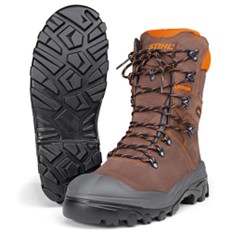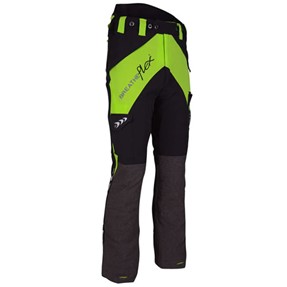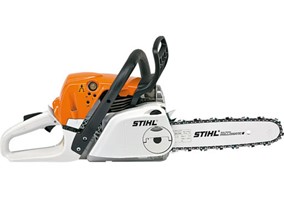
Chainsaw Safety 101: Tips for Safe Chainsaw Operation
Using a chainsaw can be an incredibly efficient way to handle heavy-duty cutting tasks, from felling trees to cutting firewood. However, it’s crucial to understand that
operating a chainsaw
also comes with significant risks. By following proper safety protocols, you can minimise the danger and ensure a safe and efficient experience.
In this blog, we’ll cover essential tips for safe chainsaw operation, whether you’re using a petrol chainsaw, a cordless chainsaw, or any other type of chainsaw.
Understand Your Chainsaw
Before you even think about starting your chainsaw, it’s important to familiarise yourself with its components and functions. Read the manufacturer's manual thoroughly to understand the specific safety features
and operational guidelines for your model.
Whether you’re using a petrol chainsaw or a cordless chainsaw, each model has unique characteristics that you should be aware of.
Wear Proper Safety Gear
Safety gear
is non-negotiable when it comes to operating a chainsaw.
Ensure you have the following protective equipment:
- Helmet: Protects your head from falling branches and debris.
- Visor or Safety Goggles: Shields your eyes from flying wood chips.
- Ear Protection: Chainsaws can be extremely loud, and prolonged exposure can damage your hearing. Headphones or earplugs will be your friend while you work.
- Gloves: Provide a better grip and protect your hands from cuts.
- Chainsaw Trousers or Chaps: Specially designed to provent serious injury if the chainsaw contacts your legs.
- Chainsaw Safety Boots: Offer protection for your feet and improve stability while working with a chainsaw.
Once you have the proper safety gear, you can start the next stage of the process. Before making any cuts, it’s important to take time to plan your work. Assess the tree for dead branches that might fall and determine the direction in which the tree will fall. Clear the area of any obstacles to ensure there’s a clear path for retreat. Also, plan an escape route and keep it clear in case the tree falls unexpectedly.
Proper Handling and Operation of Your Chainsaw
How you handle and operate the chainsaw significantly impacts your safety. Always grip the chainsaw firmly with both hands to maintain control. Your stance is crucial; stand with your feet shoulder-width
apart to ensure stability. When starting a petrol chainsaw, make sure it is on a flat surface. For cordless chainsaws, ensure the chain brake is engaged before starting. Use the lower part of the chainsaw
bar for cutting and avoid cutting with the tip to prevent kickback.
Kickback is one of the most dangerous hazards when using a chainsaw. It occurs when the chain on the tip of the bar catches on wood and throws the saw back towards the operator. To prevent kickback, use a
chainsaw equipped with a chain brake, as this feature can stop the chain almost instantly if kickback occurs. Avoid cutting with the tip of the chainsaw bar and instead use the lower part. Keeping the chain
sharp is also vital because a dull chain is more likely to cause kickbacks.
Never stand directly behind the chainsaw; instead, stand to the side to avoid the path of potential kickback. It's also important to be constantly aware of your surroundings, ensuring that no one is within
the safety radius of the chainsaw.
Post-Operation Safety
Once you’ve completed your cutting tasks, it’s essential to follow a series of post-operation safety procedures to ensure your chainsaw remains in good condition and ready for future use. Firstly,
turn off the chainsaw properly. For petrol chainsaws, this means switching off the engine. For
cordless chainsaws
, you should remove the battery to ensure there is no accidental activation.
After turning off your chainsaw, take the time to inspect it thoroughly for any signs of damage or wear. Check the chain for any dullness or damage and ensure it is properly tensioned. Examine
the guide bar
for any signs of wear or damage, as well as the chain brake and other safety features to make sure they are functioning correctly. If you notice any issues, address them immediately. This might involve
sharpening the chain, replacing worn parts, or consulting a professional for more complex repairs.
Cleaning your chainsaw after use is also a critical step in post-operation safety. Remove any debris, wood chips, or sawdust that may have accumulated in the chain and housing.
For petrol chainsaws, also check the air filter and clean it if necessary. This helps maintain the chainsaw’s efficiency and longevity.
Proper storage of your chainsaw is another important aspect of post-operation safety. Store your chainsaw in a dry, secure place, away from children and pets. It should be placed in a location where
it won’t be accidentally knocked over or exposed to moisture, which could cause rust or other damage. If your chainsaw has a protective cover or case, use it to protect the chain and bar. Additionally,
for petrol chainsaws, consider draining the fuel if you plan not to use the chainsaw for an extended period. Stale fuel can cause starting problems and may damage the engine. For cordless chainsaws, store
the battery separately and in a cool, dry place, ensuring it’s charged according to the manufacturer’s recommendations to maintain battery health.
Make Sure to Maintain Your Chainsaw
Regular maintenance of your chainsaw is crucial for both safety and performance. Here are some quick maintenance tips:
- Check the Chain: Ensure it is sharp and properly tensioned.
- Inspect the Chain Brake: Test it regularly to make sure it functions correctly.
- Clean the Air Filter: A clean air filter ensures your chainsaw runs efficiently.
- Check Fuel Levels: For petrol chainsaws, make sure you use the correct fuel mix as recommended by the manufacturer.
- Charge the Battery: For cordless chainsaws, ensure the battery is fully charged and in good condition.
Looking for a New Chainsaw or Advice?
Operating a chainsaw safely requires knowledge, preparation, and the right equipment. By understanding your chainsaw, wearing appropriate safety gear, maintaining your equipment, and following safe
operating procedures, you can significantly reduce the risks associated with chainsaw use. Whether you’re using a petrol chainsaw or a cordless chainsaw, these tips will help ensure your safety and the
safety of those around you. Remember, safety first!
For more information on chainsaws and safety equipment,
visit Highland Industrial Supplies in-store.
Our experts are always ready to help you find the right tools and gear for your needs. Looking for a new chainsaw? Have a look while you’re in-store or shop
our range
online. Stay safe and happy cutting!








